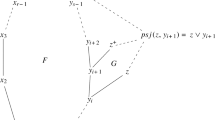Abstract
A structural framework is presented which allows the systematic determination of all non-isomorphic posets on n points with at least τ ⋅ 2n downsets, or - equivalently - of all T0-topologies on n points with at least τ ⋅ 2n open sets. The framework is developed by defining the type of a special extension of posets and by defining a partial order on these types. It is shown that this partial order is strictly antitone to the number of downsets of so called simple extensions; additionally the downset number of a simple extension is the maximum of the downset numbers of all extensions having the same type as the simple extension. For non-simple extensions of an important type it is shown that the number of their downsets is ruled by a simple sub-extension contained in them. The approach is used to determine all non-isomorphic posets with at least \( \frac {1}{4} \cdot 2^{n}\) downsets. Finally, a result of Vollert about the structure of downset numbers is refined.
Similar content being viewed by others
References
Aigner, M.: Kombinatorik I. Grundlagen und Zähltheorie. Springer-Verlag, Berlin (1975)
Alexandroff, P.: Sur les espaces discrets. Comptes Rendus de l’Académie des Sciences 200, 1469–1471 (1935)
Alexandroff, P.: Diskrete Räume. Mat. Sb. (N.S.) 2, 501–518 (1937)
Benoumhani, M.: The number of topologies on a finite set. J. Integer Seq. 9, Article 06.2.6 (2006)
Benoumhani, M., Kolli, M.: Finite topologies and partitions. J. Integer Seq. 13, Article 10.3.5 (2010)
Birkhoff, G.: Lattice Theory, 3rd edn., vol. 25. Proc. Amer. Math. Soc. Coll Publ., Providence (1973)
Brinkmann, G., McKay, B. D.: Posets on up to 16 Points. Order 19, 147–179 (2002)
Brinkmann, G., McKay, B. D.: Counting unlabelled topologies and transitive relations. J. Integer Seq. 8, Article 05.2.1 (2005)
Butler, K. K. -H.: The number of partially ordered sets. J. Combin. Theory (B) 13, 276–289 (1972)
Butler, K. K. -H., Markowsky, G.: Enumeration of finite topologies. In: Proc. 4th Southeastern Conf. on Combinatorics Graph Theory and Computing, pp. 169–184. Winnipeg (1973)
a Campo, F., Erné, M.: Exponential functions of finite posets and the number of extensions with a fixed set of minimal points. To appear in J. Combin. Math. Combin. Comput.
Culberson, J. C., Rawlins, J. E.: New results from an algorithm for counting posets. Order 7, 361–374 (1991)
Erné, M.: Struktur- und Anzahlformeln für Topologien auf endlichen Mengen. Westfälische Wilhelms-Universität zu Münster, PhD Dissertation (1972)
Erné, M: Struktur- und Anzahlformeln für Topologien auf endlichen Mengen. Manuscripta Math. 11, 221–259 (1974)
Erné, M.: On the cardinalities of finite topologies and the number of Antichains in partially ordered sets. Discrete Math. 35, 119–133 (1981)
Erné, M.: The number of partially ordered sets with more points than incomparable pairs. Discrete Math. 105, 49–60 (1992)
Erné, M., Heitzig, J., Reinhold, J.: On the number of distributive lattices. Electron. J. Comb. 9, #R24 (2002)
Erné, M., Stege, K.: Counting finite posets and topologies. Order 8, 247–265 (1991)
Erné, M., Stege, K.: Combinatorial applications of ordinal sum decompositions. Ars Combinatoria 40, 65–88 (1995)
Heitzig, J., Reinhold, J.: The number of unlabeled orders on fourteen elements. Order 17, 333–341 (2000)
Heitzig, J., Reinhold, J.: Counting finite lattices. Algebra Universalis 48, 43–53 (2002)
Kolli, M.: Direct and elementary approach to enumerate topologies on a finite set. J. Integer Seq. 10, Article 07.3.1 (2007)
Kolli, M.: On the cardinality of the T 0-topologies on a finite set. Intern. J. of Combin., Article ID 798074. (2014) https://doi.org/10.1155/2014/798074
Parchmann, R.: On the cardinalities of finite topologies. Discrete Math. 11, 161–172 (1975)
Pfeiffer, G.: Counting transitive relations. J. Integer Seq., 7 (2004), Article 04.3.2
Ragnarsson, K., Tenner, B. E.: Obtainable sizes of topologies on finite sets. J. Combin. Theory (A) 117, 138–151 (2010)
Sharp, H.: Quasi-orderings and topologies on finite sets. Proc. Amer. Math. Soc. 17, 1344–1349 (1966)
Sharp, H.: Cardinality of finite topologies. J. Combin. Theory 5, 82–86 (1968)
Stanley, R. P.: On the number of open sets of finite topologies. J. Combin. Theory (A) 10, 74–79 (1971)
Stanley, R. P.: Ordered Structures and Partitions. PhD thesis, Harvard (1971)
Stanley, R. P.: Ordered structures and partitions memoirs of the AMS (1972)
Stanley, R. P.: Enumerative combinatorics, 2nd edn, vol. I. Cambridge University Press (2012)
Vollert, U.: Mächtigkeiten von Topologien auf endlichen Mengen und Cliquenzahlen in endlichen Graphen. University of Hannover, PhD Thesis (1987)
Acknowledgements
I am grateful to Marcel Erné and to the anonymous reviewer #2 of this paper for their useful hints and recommendations in writing and improving this paper.
Author information
Authors and Affiliations
Corresponding author
Appendix
Appendix
Admissible extensions R ∈ E(P, m) with P ∈ Z(k) (cf. Table 1)
Admissible extensions R ∈ E(C2 + Aℓ,m), ℓ ≥ 1 (cf. Table 2). The coding is: type of C2 in R, a = max{ϕ(R) (y) | y ∈ Y}
Admissible extensions R ∈ E(P′ + Aℓ, m), P′ ∈ Z(k′), k′ ≥ 3, ℓ ≥ 1 (cf. Table 3)
Admissible extensions R ∈ E(Ak,m) with k ≤ m (cf. Table 4). The admissible extensions with k > m are found by turning upside-down the admissible extensions found in E(Am,k)
Non-connected lower extensions R without isolated points with \(\delta (R) \geq \frac {1}{4}\) (cf. Table 5). In order to be consistent with the previous figures, m is in this figure for every extension the number of minimal points of the connectivity component on the right. Each connectivity component can be replaced by its dual
Rights and permissions
About this article
Cite this article
a Campo, F. A Framework for the Systematic Determination of the Posets on n Points with at Least τ ⋅ 2n Downsets. Order 36, 119–157 (2019). https://doi.org/10.1007/s11083-018-9459-2
Received:
Accepted:
Published:
Issue Date:
DOI: https://doi.org/10.1007/s11083-018-9459-2








